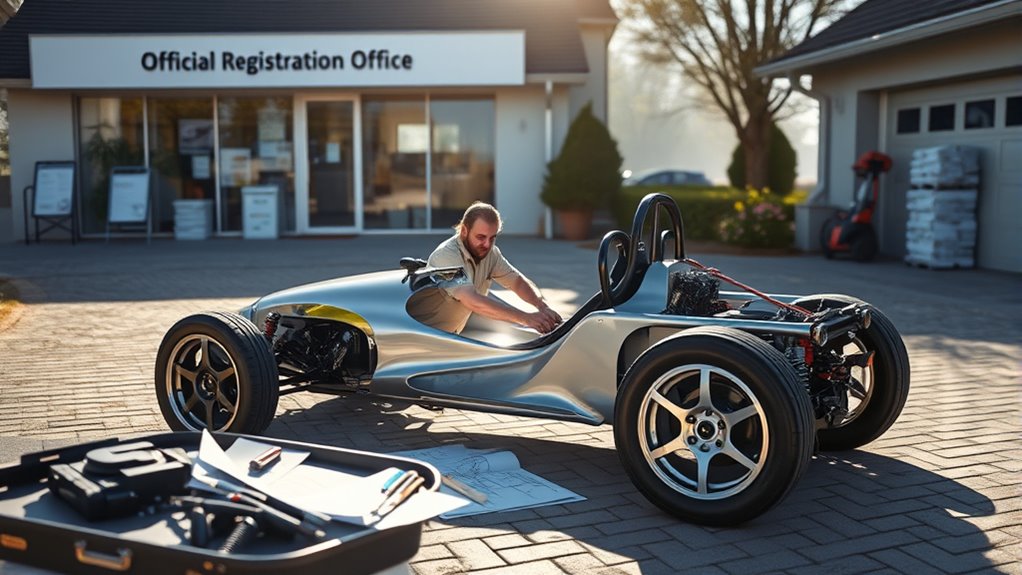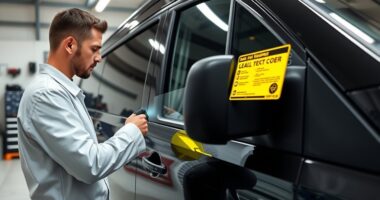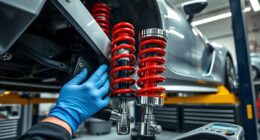To register your kit car, you need to pass a thorough inspection that checks safety, build quality, and emissions standards, which varies by location. Be prepared with detailed documentation like receipts, photos, and assembly instructions to prove proper construction and compliance. You’ll also need to submit proof of ownership and possibly VIN verification. Once your vehicle passes inspection and your paperwork is approved, you’ll receive registration and plates. Keep going to learn more about the detailed steps involved.
Key Takeaways
- Complete the vehicle inspection to verify safety, build quality, and proper assembly by a qualified inspector.
- Gather all necessary documentation, including receipts, photos, assembly instructions, and proof of ownership.
- Ensure the vehicle passes emissions testing or meets alternative fuel vehicle requirements per local regulations.
- Submit all required documents, such as inspection certificates and proof of ownership, to the DMV for review.
- Obtain registration and license plates from the DMV once all legal requirements and documentation are approved.

Registering a kit car can seem intimidating, but understanding the process makes it much more manageable. The first step involves steering the inspection process, which is vital to ensure your vehicle meets safety and emissions standards. During this phase, a qualified inspector will examine your kit car to verify that it complies with local regulations. They’ll check the structural integrity, safety features, and overall build quality. This step can be straightforward if you’ve followed proper assembly guidelines and have kept detailed records of your build. It’s important to make sure that all components are securely installed and that your vehicle is roadworthy before the inspection. Preparing documentation such as receipts, assembly instructions, and photos can streamline this process and demonstrate that your kit car was assembled correctly. Proper documentation is essential for establishing the authenticity and compliance of your build, especially when verifying quality assessment or adherence to manufacturing standards. Next, you’ll need to focus on meeting emission standards, which vary depending on your jurisdiction. Many regions require your vehicle to pass an emissions test to ensure it doesn’t pollute excessively. This often involves connecting your vehicle to a testing station where emissions are measured against the legal limits. If your kit car is powered by a conventional engine, verify it has the appropriate emissions control devices installed—like catalytic converters or oxygen sensors—so it can pass inspection. For electric or alternative fuel vehicles, the process might differ slightly, but you’ll still need to show compliance with environmental standards. Failing to meet emission standards can delay registration or require modifications to your vehicle. Once your kit car successfully passes the inspection process and emissions testing, you’ll typically need to submit a series of documents to your local motor vehicle department. These include the inspection certificate, proof of ownership (such as receipts or a bill of sale), and any additional paperwork required by your jurisdiction. Some regions might also require a VIN verification, especially for custom-built vehicles. After reviewing your documentation and confirming your vehicle complies with all safety and environmental standards, the DMV will issue your registration and license plates. Keep in mind that fees, registration procedures, and specific requirements can vary widely, so it’s a good idea to consult your local DMV or transportation authority beforehand.
Frequently Asked Questions
Do Kit Cars Require a Vehicle Identification Number (VIN)?
Yes, kit cars do require a Vehicle Identification Number (VIN). According to kit car regulations, you must obtain a VIN for your vehicle to guarantee proper registration. The VIN verification process confirms the originality and compliance of your kit car with safety standards. Without a VIN, registering your kit car becomes difficult, as authorities need this unique identifier to track ownership and ensure it meets legal requirements.
How Long Does the Registration Process Typically Take?
You might wonder how long registration takes, but don’t worry—most kits are processed within a few weeks. The registration timeline can vary depending on your location and any processing delays, but typically, you can expect about 2 to 6 weeks. To avoid unnecessary delays, make certain all your paperwork is complete and accurate. Staying patient during processing delays will help you get your kit car registered smoothly and quickly.
Are There Specific Emissions Tests for Kit Cars?
For kit cars, emissions testing requirements vary by state. Many offer an emissions exemption for vehicles built from scratch, but some still require testing to meet safety and environmental standards. It’s essential that you check your local Department of Motor Vehicles (DMV) for specific emissions testing requirements. If your state grants an emissions exemption, you may not need to undergo standard testing, simplifying the registration process for your kit car.
Can I Register a Kit Car as an Electric Vehicle?
Like harnessing the future, you can register your kit car as an electric vehicle, enabling benefits like electric vehicle incentives. To do so, you’ll need to meet battery technology regulations and guarantee your build complies with emissions standards. Think of it as turning your DIY project into a clean, green machine, where innovation meets regulation. With proper documentation and adherence to rules, your electric kit car can roll smoothly through registration.
What Insurance Coverage Is Needed for a Kit Car?
You need at least minimum insurance coverage to legally drive your kit car. Check your state’s insurance requirements to guarantee compliance. Consider coverage options like liability, extensive, and collision insurance to protect against accidents, theft, and damages. It’s wise to get a policy that matches the vehicle’s value and usage. Always compare providers, understand the policy details, and confirm that your coverage meets legal standards before hitting the road.
Conclusion
Registering your kit car is like planting a seed—you nurture it through each legal step, watching it grow from a bare frame into a symbol of your craftsmanship. As you cross the finish line of paperwork and inspections, you bring your creation to life, ready to hit the open road. Remember, this journey transforms your vision into a living, breathing machine—an emblem of your passion and dedication, ready to carve its mark on the highway.










